Tim Warnes's Blog: My Life in Books, page 14
October 2, 2020
'Fox’s Garden' - and the power of silence.

Fox’s Garden by Princesse Camcam (Enchanted Lion 2014) | Illustration © 2013 by Princesse Camcam
In the end, we will remember not the words of our enemies, but the silence of our friends.
— Martin Luther King Jr
When I’m illustrating a picture book, one thought usually crosses my mind: I wonder if I’d be allowed a silent spread?
Wordless (silent) spreads are, to me, the Holy Grail. They create a pause in a story, allowing the art to shine - and speak.
“Words are left out - but the picture says it,” said Maurice Sendak. “Pictures are left out - but the word says it.”
Financial constraints mean they rarely happen. But when they do, the picture book is elevated to new heights. (Think of Sendak’s Where the Wild Things Are which has three (count them!) incredible wordless spreads which describe the wild rumpus - through the art alone.)
Perhaps even rarer than picture books with wordless spreads, are those with no words at all.
Wordless books “prompt questions on the direction of [the] narrative and what’s happening on the page,” said publisher Marc Drumwright, of Enchanted Lion. “It’s a kind of engagement [with reading] you don’t often see.”
That engagement takes effort on the part of the reader - including the adult who may be sharing the book with a child. When it came to his own wordless offering, Clown, Sir Quentin Blake noted this made some parents dissatisfied:
“…[E]ffort, however, is always called for, especially in a collaborative reading; and one of the incidental interests of [wordless books like Clown] is perhaps that it prevents you from assuming that you know a book because you have recited the words, in the same way that people assume they have grasped the Mona Lisa because their gaze has passed over its surface.”
- Quentin Blake, Words and Pictures
Wordless books demonstrate exactly why illustrators are as much the author of a picture book as the writer using words.
(For more on this, take a look at my previous article, Why I dislike the word ‘Author’.)
This is reading - visual literacy at the zenith of its powers!
So of course, my Good to Read recommendation this week has to be a story with no words - Fox’s Garden by Princesse Camcam (Enchanted Lion 2014).
Initially published in France as Une rencontre, Fox’s Garden was translated and released to a broader audience by Enchanted Lion, a small, independent publishing house in Brooklyn, N.Y.Ears back, tail between its legs, Fox slinks between skeletal winter trees.
Ploughing ahead - despite the deep, drifting snow.

Fox’s Garden by Princesse Camcam (Enchanted Lion 2014) | Illustration © 2013 by Princesse Camcam
It instantly reminded me of a moonlit winter walk that I took Noah on when he was about seven. We don’t often get snow here, so it was a Significant Event - and a full moon made for a truly magical experience.
Beautiful, mysterious and dreamlike.
Like the magical atmosphere created by Slava’s Snow Show.
These are the sensations and experiences conjoured by Fox’s Garden!
The illustrations make this wordless story rather unique, too [1]. Camcam created cut-paper dioramas, which were then skilfully lit and photographed.
Camcam lights her paper work beautifully..., almost as if it were a stage. She conveys the welcoming warmth of the light in the village, the yellow of the windows lit against the storm. More subtly, she plays with shadows and underlighting in specific scenes, showing the cold and the night clearly.
- Wakingbraincells.com
Crisp foregrounds contrast with out of focus backgrounds, creating tremendous depth of field that pulls the reader in - just as the fox is drawn down to the warm glow of the village.

Fox’s Garden by Princesse Camcam (Enchanted Lion 2014) | Illustration © 2013 by Princesse Camcam | Image source: Enchantedlion.com
The Fox is not a welcome visitor. Chased away, it creeps into an icy-cold greenhouse. I can imagine the painful cold of that frosted glass.
Camcam’s art is intricate and delicate. The background sky swirls wildly, like van Gogh’s starry nights. The russet fox pops against the haunting lilac and blue backdrops. ‘[E]ven the flowers in the greenhouse are rendered in wintry blues and grays that make the glow of lights seen through windows seem achingly warm but remote’.
No wonder Fox’s Garden was recognised with a 2015 USBBY Outstanding International Book award.
Fortunately for Fox, someone else is watching. Someone with a warmer heart - a little child.

Fox’s Garden by Princesse Camcam (Enchanted Lion 2014) | Illustration © 2013 by Princesse Camcam
Wrapped up warmly, with basket in hand, they head out to the fox.

Fox’s Garden by Princesse Camcam (Enchanted Lion 2014) | Illustration © 2013 by Princesse Camcam | Image source: Enchantedlion.com
The next spread is so good! The child peers into the moonlit greenhouse, with its icy flowers and gardener’s tools. Viewed from a low angle, adjacent to the sleeping fox, we watch as the child crouches. They gently push the basket and its offering towards Fox. Alert now, with ears pointed forward, Fox watches. Look closely! Do you see the four, suckling kits?
I get the impression the child knew there was a family to care for. Back in the warmth of his room, above his bed, is a drawing of the fox. I know if I had been that child, I would have been watching ever so closely.
Now here’s the magic: as the child sleeps, the vixen leads her family towards the sleeping house. Each fox carries a greenhouse flower in its mouth. The floral banners are held high, transforming what has been a believable scenario into something somewhat dreamlike. The foxes jump in through the child’s bedroom window - and when they awake the following morning, they discover their own patch of flowery garden, growing from the bedroom rug. A ‘thank you’ from the foxes.
Perhaps it is a fond farewell too, as the story ends with the vixen leading her kits up into the hills and the birch woodland. And that is the joy of wordless stories - they are open to interpretation.
As Emily Dickinson wrote, Saying nothing sometimes says the most.

Fox’s Garden by Princesse Camcam (Enchanted Lion 2014) | Illustration © 2013 by Princesse Camcam
Wordless stories are organic and living. They place the reader in the role of storyteller, empowering them to collaborate with the author. This book is a teacher’s dream: Give Fox’s Garden to a group of kids, and each will tell their own variation of events. There is no right or wrong - leaving plenty of room for speculation and discussion.
And that is a powerful experience for any child.
Notes[1] Take a look at Lauren Child’s The Princess and the Pea and The Colour Monster by Anna Llenas for similarly created illustrations.See more from Enchanted Lion
GOOD TO READ
Wordless picture books
Clown by Quentin Blake (Jonathan Cape 1995)
The Snowman by Raymond Briggs (Hamish Hamilton 1978)
Fox’s Garden by Princesse Camcam (Enchanted Lion 2014)
The Chicken Thief by Beatrice Rodriguez (Gecko Press 2009)
(Almost) wordless picture books
Hug by Jez Alborough (Walker Books 2000)
Banana by Ed Vere (Puffin 2007)
Sourceswisdomquotes.comEssay |Enchanted Lion by Jude Stewart (DesignObserver.com, November 23, 2018)Fox’s Garden by Princesse Camcam (Enchanted Lion 2014) Review: FOX’S GARDEN BY PRINCESSE CAMCAM (Wakingbraincells.com, November 12, 2014) Review: Fox’s Garden (Kirkus Review, August 12, 2014) © 2020 BY TIM WARNES (UNLESS OTHERWISE ATTRIBUTED)****USE OF THIRD PARTY COPYRIGHTED MATERIAL FALLS UNDER FAIR USE/FAIR DEALING PRACTICE.September 25, 2020
Surviving Lockdown with the Munchies
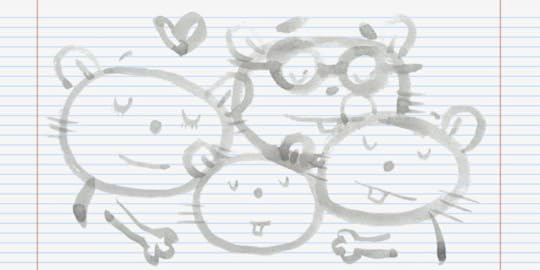
Gus Munchie: My Lockdown Diary | Illustration © 2020 Tim Warnes
Whatever the new normal brings, we’ll face it together. That’s what makes us strong.
— Gus Munchie
I began writing Gus Munchie: My Lockdown Diary at the start of lockdown here in the UK.
As with most things creative, it took me longer than anticipated. So, by the time I was ready to release Gus Munchie online, coronavirus restrictions were easing, and the world was attempting to get ‘back to normal.’ After all my hard work, I was concerned I’d missed my opportunity - that it would be old; that the world was moving on.
But this week, the US coronavirus death toll passed 200,000. Meanwhile, ‘the number of schools in England sending home groups of pupils because of Covid-19 incidents has quadrupled.’ We’re feeling less optimistic - and Gus Munchie: My Lockdown Diary is still, sadly, all-too relevant.
Back in June 2020, the Childhood Trust warned that ‘[c]hildren are developing serious mental health conditions, including post-traumatic stress, because of the coronavirus pandemic’. Parents are left wondering: How am I meant to talk with my kids about what’s going on? (No one wants to add to the fear and worry their kids may already be experiencing.)
So the question is: What can we, the adults, do to support our kids as we move forward? And how can Gus Munchie help?
There’s some excellent articles by the Child Mind Institute - Talking to kids about the Coronavirus Crisis and Supporting Kids During the Coronavirus Crisis.
They helped guide my ideas when writing Gus Munchie. So, using some of their wisdom, let me show you how My Lockdown Diary models good practice and how it can have a positive influence on your kids.
View conversations that arise around COVID as an opportunity not just to convey the facts but to set the emotional tone.Take your cues from your child. Invite them to share what they may have heard about the coronavirus, and how it makes them feel.“I know all this is hard, Munch,” says Mama. “It’s an emotional roller coaster for us all. But we’ll get through it. Because we’re family.”
…
Then they join in and we have a great, big, cuddle sandwich, right there on my bed.

Gus Munchie: My Lockdown Diary | Illustration © 2020 Tim Warnes
Be reassuring: very few kids are getting sick, and they’re unlikely to catch it.“Whatcha doing, Munch?” asks Mama.
I like it when Mama calls me Munch. It makes me feel all cosy.
I show her my drawing of COVID on its rampage of death.
“Want to talk about it” asks Mama.
Emphasise what you’re doing to stay safe. Reassure kids by reminding them of the precautions that you’re taking.“Me no wan’ die!” says Lunchbox. “Me toot ham-ham!”
(I have to admit, Lunchbox is pretty cute.)
“You won’t die, Munchkin,” says Mama.
‘Kids feel empowered when they know what to do to keep themselves safe.’
The doorbell rings.
Under the circumstances, this is an Exciting Event.
Dad answers it, wearing a paper bag on his head for protection.
“Listen, Stinks,” I say, putting my arm around him. “We just have to remember to wash our paws. D’you think you can do that?”
Lunchbox nods. “Uh-huh.” I wipe his sticky, wet cheeks on his Noo-Noo.
Mama gives me one of her sweet smiles and a thumbs up.
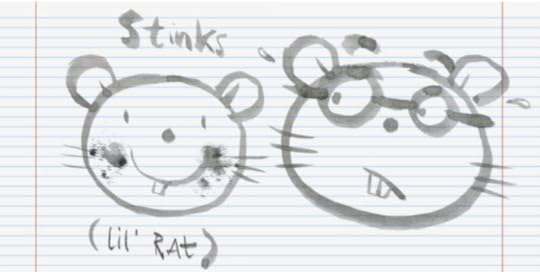
Gus Munchie: My Lockdown Diary | Illustration © 2020 Tim Warnes
Make use of technology to help younger kids feel closer to relatives or friends.
‘ It’s not perfect, but it helps us all feel closer and less stressed. ’
It’s time to video call Nana and Grampa Tubb….
‘Greetings, Munchies!’ says Grampa. ‘How are you diddling?’
We chat about irrelevant, everyday things - like the weather and Grampa’s beans. It’s good to see them, and almost feels like normal. Until Gramps starts singing:
‘We’ll meet again, don’t know where, don’t know when…”
And then Mama has a little cry.
So yes, there are tender and poignant moments. But the bottom line is, Gus Munchie is entertaining! So, read it to your kids (at home, or, if you’re a teacher, in the classroom ). If a child is confident enough, they can read it by themselves - alone or out loud to you. Either way, you are supporting them with their literacy.
Grandparents: Maybe you are shielding, or find yourself separated by distance or lockdown restrictions, unable to be with children you love. Well, what’s to stop you video chatting with the grandkids every night and reading Gus Munchie (or any story for that matter) at bedtime? Remember: Gus Munchie creates an opportunity to connect emotionally over something much bigger than us all.
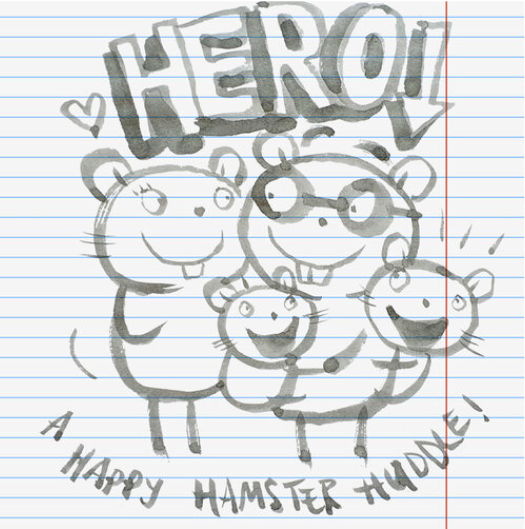
Gus Munchie: My Lockdown Diary | Illustration © 2020 Tim Warnes
Kids worry more when they’re kept in the dark. Gus Munchie is one way to bring those fears and uncertainty into the light.
Snuggle up together. Laugh - or have a moan - together. Maybe even share some tears. By doing so, you will be creating opportunities, as described above, to to create opportunities to talk with your child about the pandemic.
We are navigating uncharted waters. We are all in the same boat - even if we have different responses to coronavirus.
But I think it’s safe to say, we all agree with Daddy Munchie: “Lockdown sucks!”
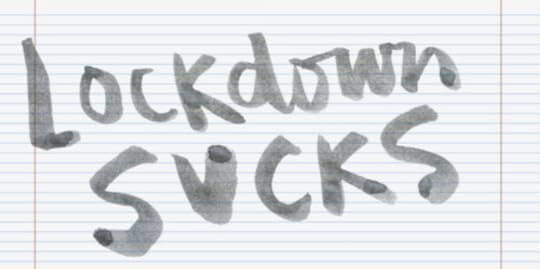
Gus Munchie: My Lockdown Diary | Illustration © 2020 Tim Warnes
SUPPORT YOUR KIDS - SIGN UP TO GUS MUNCHIE: MY LOCKDOWN DIARY(RECOMMENDED AGES: SEVEN - ADULT)
14 daily instalments to entertain and connect you with your kids. Delivered to your inbox - exclusive to this site!
GET FREE ACCESS NOW!
I’m honoured to announce that I will be a guest on next week’s K11 KULTURE WEBINAR SERIES - a live web dialogue brought to you by K11 MUSEA.

“In this global series, we will bring together renowned cultural experts and professionals from around the world to inspire and empower the next generation of changemakers through the power of culture, creativity social innovation and sustainability, with an aim to build a better post-COVID-19 world together.”
(09:00 U.K. time)
Register for the free webinar here !SourcesGUS MUNCHIE: MY LOCKDOWN DIARY BY TIM WARNES (2020)Supporting Kids During the Coronavirus Crisis (Child Mind Institute)Coronavirus: Children 'developing post-traumatic stress' from pandemic (bbc, june 22, 2020)Quadrupling in schools sending pupils home in Covid cases (bbc, september 22, 2020)Covid: US death toll passes 200,000 (bbc, september 23, 2020) Talking to Kids About the Coronavirus Crisis by Rachel Ehmke (Child Mind Institute)September 18, 2020
How Gus Munchie can help your kids through the pandemic
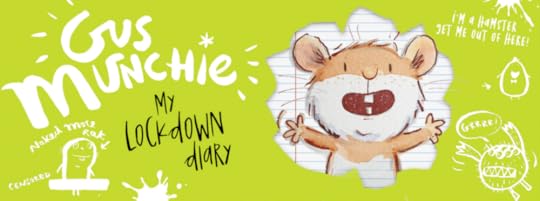
Gus Munchie: My Lockdown Diary | Illustration © 2020 Tim Warnes
Charlie Cook has to stay in his house.
He reads to the cat and he reads to the mouse.
— Julia Donaldson
Yesterday I saw the sweetest baby. I was standing at the counter of a favourite haunt, Feed the Soul, and she just crawled in, wearing a white cotton dress.
She gazed up at me; I smiled back. And I wondered: Whatever must she make of me?
“Doesn’t my mask freak her out?” I asked her mummy, who appeared in the doorway.
“She’s not phased at all,” replied the mummy, scooping her up into a warm embrace.
(To prove it, the little baby gave me a tiny, shy smile.)
“She’s got used to them.”
And what of slightly older kids? The new term has begun, and they’re back to school - all of which ‘face unprecedented challenges… Some have opted for socially distanced classes, others for virtual lessons, or a hybrid of both. And, of course, plans may change at any time.’
Within the first four days of children going back, three of my local schools had closed again. (I live in rural Dorset in the south-west of England. Interestingly, these closures weren’t featured on national news, leaving me asking, What else is going on that we’re not hearing about?)
This may be new - but it is far from normal.
A new day. Same old lockdown.
The doorbell rings.
Under the circumstances, this is an Exciting Event.
Dad answers it, wearing a paper bag on his head for protection.
That’s from Gus Munchie: My Lockdown Diary. I wrote it in the spring during lockdown - my personal, creative response to being thrown headlong (along with everybody else) into the pandemic crisis.
Gus Munchie is an anthropomorphic hamster, and the story is his account of lockdown, written in the form of a diary. I guess he would be a tween: no longer a little child, but not quite a teenager... and [his] behavior and emotions reflect that.’
Gus’ story - and that of his family - reflects the realities of lockdown and how we have found our own ways to remain optimistic. The resulting tale, with its pathos, drama and humour, is uplifting and entertaining.
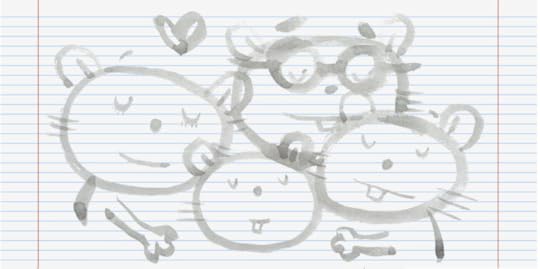
Gus Munchie: My Lockdown Diary | Illustration © 2020 Tim Warnes
Passing the understairs cupboard, I hear a strange rustling coming from inside. Hamsters are notoriously inquisitive, so I take a look.
“What are you up to, Dad?” I ask.
He looks very shifty - as if I’ve just caught him with his trousers down.
Except we don’t wear trousers.
As if I’ve just caught him with a secret stash of sweet and nutty treats. Which I have!
Uh-oh! Dad’s reverting to Wild Behaviour.
Is Gus Munchie’s Lockdown Diary about the coronavirus pandemic? Yes - and No. Yes, because I think it is a useful tool for inspiring conversation and connection. (I shall explain why in greater detail next week).
No - because the pandemic is the catalyst for the story. I use it to provide the inciting incident (Lunchbox’s cough) that destabilises the Munchie’s world. After the initial reality check in Chapter Two, I don’t mention coronavirus a great deal. It’s the hook I hang my story on - what it’s really about is Gus, and his relationship with his dad, Fat Tony.
Gramps says Dad used to be a long-haired hippy hamster. But now his fur’s all patchy and thin.
“What are you staring at?” says Dad.
“Your fur,” I say. “You’re going bald. You realise if you go completely bald you’ll look like a naked mole rat?”
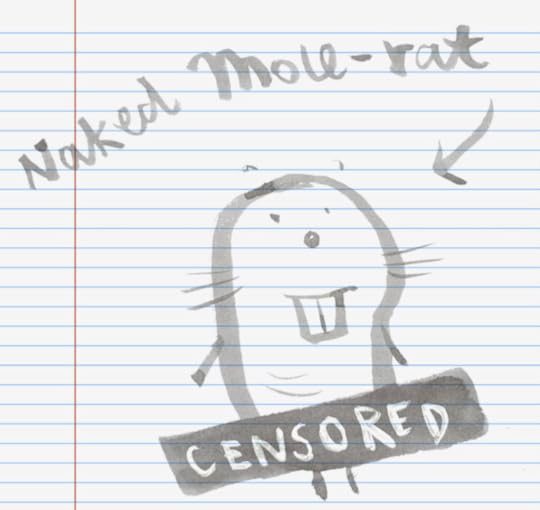
Gus Munchie: My Lockdown Diary | Illustration © 2020 Tim Warnes
I did, however, get to riff on naked mole rats (thanks to Gus’s dad):
Dad has taken it upon himself to teach us nature studies during lockdown, on account of his passion for all things wildlife-y. (And to avoid training on the Hamstercise wheel.)
The theme he’s chosen is Misfits of the Mammalian Kingdom. Oh, the irony!
My own kids are much older now (fourteen and twenty-one). But many of my friends have young children. I understand the concerns they have about how (and how much) they should be discussing coronavirus with their kids. Which is why I thought long and hard about how to tackle the subject of lockdown.
[Our children] inhabit the same world we do. They hear and see the news, they use social media. They overhear our conversations. And they talk.
They care [about coronavirus] because they hear our fears and they share them. And they need our help to work it all out.
Stop a Worry Becoming Catastrophic: How to Talk to Your Kids About the Coronavirus

Gus Munchie: My Lockdown Diary | Illustration © 2020 Tim Warnes
Next week I’ll explain how I based my decisions on what to include in Gus Munchie, and how it can help your family during the coronavirus crisis. In the meantime, you may find this earlier article helpful: Using Gus Munchie to talk to kids about COVID-19.
Because this pandemic is still far from over .
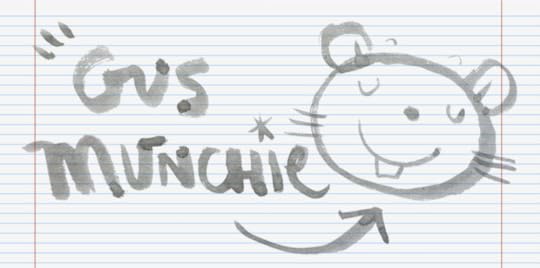
Gus Munchie: My Lockdown Diary | Illustration © 2020 Tim Warnes
SUPPORT YOUR KIDS - SIGN UP TO GUS MUNCHIE: MY LOCKDOWN DIARY(RECOMMENDED AGES: SEVEN - ADULT)
14 daily instalments to entertain and connect you with your kids. Delivered to your inbox - exclusive to this site!
Get FREE access now!
Sources The Gruffalo, Stick Man and the Smartest Giant in Town lend a paw, a stick and a hand to help with the coronavirus effort (Booktrust, 06 April, 2020)GUS MUNCHIE: MY LOCKDOWN DIARY BY TIM WARNES (2020) A Lesson in Hope: Children's Authors Who Are Teachers During Covid-19 (Children’s Bookshelf, September 15, 2020) Defining the Tween Year for Parents (Very Well Family, May 02, 2020) Using Gus Munchie to talk to kids about COVID-19 (Storyteller Tim Warnes, 03 July 2020) Stop a Worry Becoming Catastrophic: How to Talk to Your Kids About the Coronavirus (GetPocket.com, March 02, 2020) Coronavirus: WHO warns Europe over 'very serious' Covid surge (BBC, sEPTEMBER 18,2020)
September 11, 2020
The Suitcase
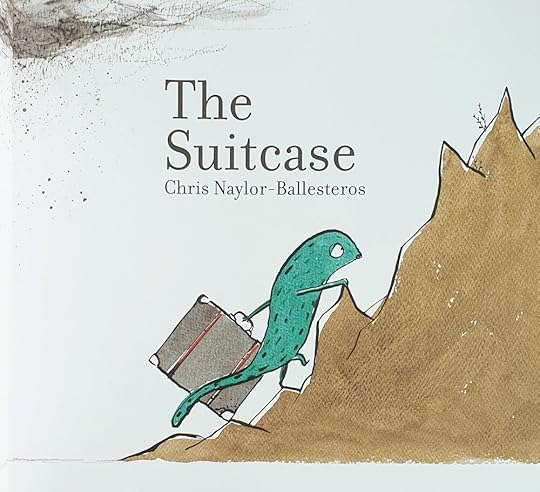
The Suitcase by Chris Naylor-Ballesteros (Nosy Crow, 2019) | © 2019 by Chris Naylor-Ballesteros
For I was hungry, and you gave Me something to eat; I was thirsty, and you gave Me something to drink; I was a stranger, and you invited Me in
— Jesus
Plenty of scientific research shows that reading fiction builds empathy.
By identifying with book characters, we learn to see things from another’s point of view; to step into someone else’s shoes.
People want to be seen.
They want to be heard - and understood.
It was the driving force behind the civil rights movement - and now the Black Lives Matters movement. It’s why victim-offender reconciliation programmes meet with success. It is the essence of empathy.
We can train even our youngest kids in kindness and empathy, through well-chosen picture books like The Suitcase by Chris Naylor-Ballesteros (Nosy Crow 2019). A ‘thought-provoking story about displacement and acceptance, The Suitcase is visually exciting and cleverly designed, and has been longlisted for the CILIP Kate Greenaway medal 2020.
The main character - a weary and lizard-like creature - is intriguing. He is hard to define - which serves to emphasise the fact that he is different. An outsider. The stranger who arrives under a dark cloud, dragging behind him an enormous suitcase. ‘Looking dusty, tired, sad and frightened,’ he is out of place - and piques everyone’s curiosity.
What a strange animal! I’ve never seen anything like him before.

The Suitcase by Chris Naylor-Ballesteros (Nosy Crow, 2019) | © 2019 by Chris Naylor-Ballesteros
In contrast, the other three players are easily identifiable as a fox, bird and rabbit. The characterisation is excellent! Naylor-Ballesteros has used ink with a dip pen to create the outlines (giving them a wonderfully variable appearance). Just look at their eyes and body language - the art speaks volumes.
The rabbit seems wary, wide-eyed.
The bird looks nervous (yet friendly) and is the first to greet the stranger: “Hey! Hi there!”
Unlike the fox, who appears somewhat irritated and suspicious - inconvenienced even. I think there’s a fair bit of fox in us all.
The dialogue sits in blocks above each character, in colours that correspond with that of the animal speaking. It’s a smart way of denoting who is speaking without any extraneous words (or the need for speech bubbles).
Another creative device is the way Naylor-Ballesteros’ uses soft, brown tones when the stranger describes the life he’s left behind. Like old, sepia-tinted photographs, they indicate memories - and give us a glimpse into his past:
… there’s a little kitchen in a wooden cabin where I make my tea. That’s my home.
It’s on a hillside surrounded by trees and on a clear day you can see the sea.
And here’s the mystery, the whole premise of the story:
It’s all there, in my suitcase.
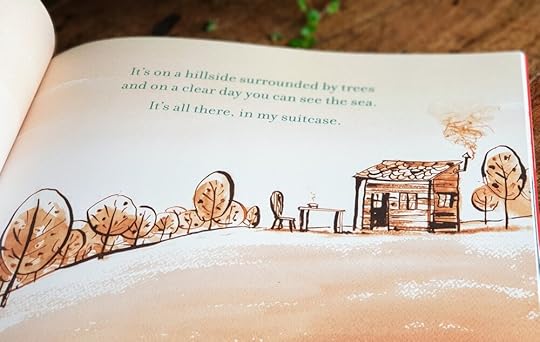
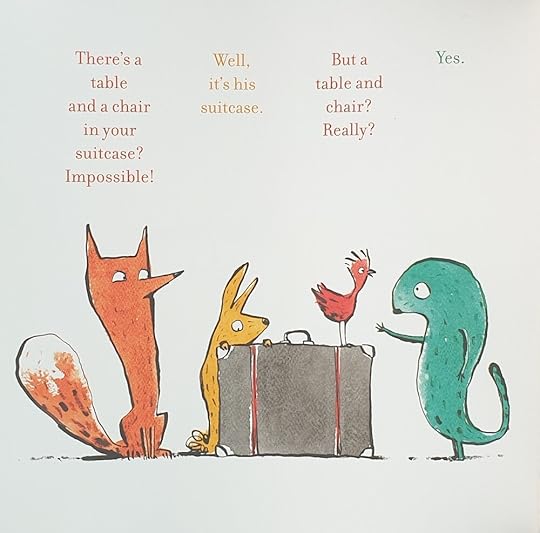
The Suitcase by Chris Naylor-Ballesteros (Nosy Crow, 2019) | © 2019 by Chris Naylor-Ballesteros
I love this idea! It’s so intriguing. And like the animals, I was desperate to see for myself the contents of that case. How could it possibly contain so much? Before any more questions can be asked, the stranger excuses himself:
… I’m sorry, I’m really very, very tired. I’ve been travelling for a long time and come a long way. I must have a little rest…
“Well, I don’t trust him,” says the fox. “How do we know he’s telling the truth?”
“We slip so easily into being tribal, into being suspicious of people who seem different to us,” writes Miranda McKearney of Empathy Lab. “The Suitcase gently and powerfully explores the transformation that comes when we manage to open our minds and hearts.”
Unfortunately, before the animals let that happen, they need to see inside the suitcase…
When I first read The Suitcase, I was shocked by what happens next, and the way that the animals’ curiosity and suspicion are played out:
“Someone pass me a big rock. We’re going to break open the suitcase and see what’s inside.”
“Maybe we should. We need to know the truth.”
“You can’t do that. It’s not ours!”
In no time at all, the suitcase was open.
“See? A broken teacup and an old photograph. He lied to us!”“Well, no… h-he did say there was a teacup.”
“Yes. And now his suitcase is broken too! What will he think of us?”
Meanwhile, the exhausted stranger sleeps, dreaming of swimming across deep (and threatening-looking) waters with his suitcase.
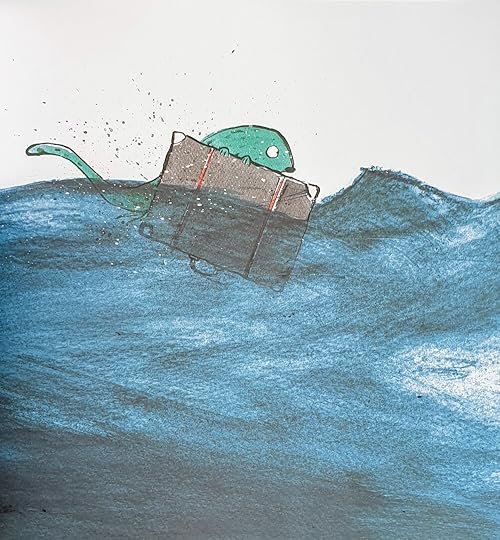
The Suitcase by Chris Naylor-Ballesteros (Nosy Crow, 2019) | © 2019 by Chris Naylor-Ballesteros
I’m loathed to reveal what happens when he wakes up - so I shan’t. Suffice to say the animals recognise their bad behaviour. They make amends, and we leave the stranger with a smile on his face. New friendships are forming. The future is bright and hopeful.
But despite the implied happily-ever-after, I found the ending is bittersweet.
Why?
Because this book touched me, reminding me, albeit in a simplistic way, the desperate plight that so many people face each day.
And that’s its power: It is challenging and thought-provoking.
“I didn’t set out to write a story explicitly about a refugee,” says the book’s creator, Naylor-Ballesteros, “but it is obviously open to that interpretation. I also like to think it could apply to any unexpected arrival that needs help and acceptance but might disturb established relationships and situations: the child that suddenly arrives out of nowhere at your school in the middle of term, the new family in your street who are apprehensive and shy. And, of course, the person who is fleeing poverty or war and has taken a huge risk to find stability and shelter. I hoped my stranger could be seen as any of these things.”
I love that quote. It reminds me of another unexpected arrival who needed help and acceptance and disturbed suburbia: Paddington! (Until I discovered a postcard of this image in Bristol, I’d never thought of him as a refugee.)
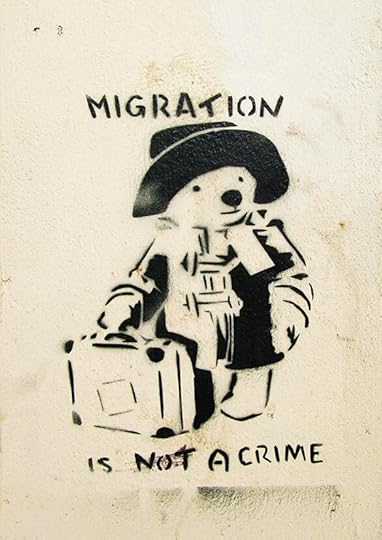
Source: Exquisite Artz
That image continues to strike a chord with me. Similarly, I think (and hope) that The Suitcase will enable us to shift our perspective. That it will challenge us to regard refugees with compassion - and as people that want (and need) to be seen and heard.
Here’s why The Suitcase is Good to Read
It’s an excellent way to start conversations with your kids about kindness and how we respond to strangers.
(Which, in turn, will develop empathy.)
The more children flex their empathy muscle, the more thoughtful they will become.
It introduces the concept of looking at a situation from different perspectives.
And here are some questions you might ask around the story:
How does the stranger feel?
Why did he make such a dangerous journey?
Why is Fox suspicious?
How would you feel if someone broke into your suitcase?
What’s with the broken teacup?
Discover more about Chris Naylor-Ballesteros’s work hereGood to readBooks for Developing EmpathyHug by Jez Alborough (Walker 2000)
King of the Sky by Nicola Davies, illustrated by Laura Carlin (Walker Books 2017)
A Little Bit Worried by Ciara Gavin, ill. by Tim Warnes (Little Tiger Press 2020)
The Colour Monster by Anna Llenas (Templar 2012)
DANGEROUS! by Tim Warnes (Little Tiger Press 2014)
My Friend is Sad by Mo Willems (Walker 2007)
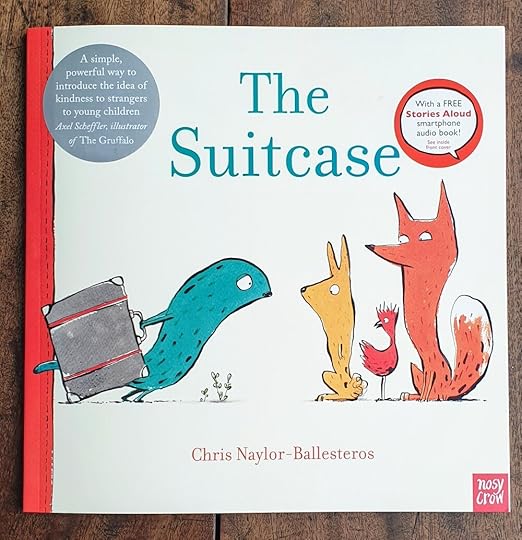
The Suitcase by Chris Naylor-Ballesteros (Nosy Crow, 2019) | © 2019 by Chris Naylor-Ballesteros
"Welcome and understanding are at the heart of this children’s book by Chris Naylor-Ballesteros. . . beautifully illustrated."
- Laura Padoan, spokesperson for UNHCR, the UN Refugee AgencyBuy US
Buy UK
SourcesJesus quoted from Matthew 25:35 (Amplified Bible) The Suitcase by Chris Naylor-Ballesteros (Nosy Crow 2019)The Suitcase: Review (Carnegiegreenaway.org.uk)The Suitcase: Review (Lovereading4kids.couk)Unpacking The Suitcase – a guest post by Chris Naylor-Ballesteros (nosycrow.com)Street Art Paddington: Exquisite Artz © 2020 BY TIM WARNES (UNLESS OTHERWISE ATTRIBUTED)****USE OF THIRD PARTY COPYRIGHTED MATERIAL FALLS UNDER FAIR USE/FAIR DEALING PRACTICE.
September 4, 2020
Representation matters!

From Only You Can Be You! by Nathan and Sally Clarkson, ill. by Tim Warnes (Tommy Nelson) | © Tim Warnes 2019
When you see something that is not right, not fair, not just, you have to speak up. You have to say something; you have to do something.
— Representative John Lewis.
Next to me are copies of two of my bear books:
I Love You as Big as the World by David van Buren (Little Tiger Press 2008) and I Love You to the Moon and Back by Amelia Hepworth (Little Tiger Press 2015). (I’m currently working on the third, I Love You Night and Day and it’s helpful to refer back to them.)
Here’s the back cover blurb from I Love You as Big as the World:
Big Bear and Little Bear love each other so much that their love stretches high up into the mountains, far away to the stars and down deep to the bottom of the sea. It is big enough to fill the whole wide world.
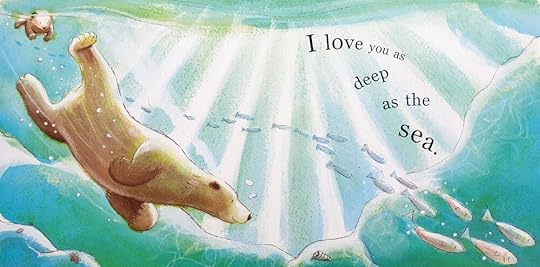
From I Love You as Big as the World by David Van Buren, ill. by Tim Warnes (Little Tiger Press 2008) | Illustration © 2008 by Tim Warnes
So much love!
It reminds me of Psalm 139:
Where can I go from your Spirit?
Where can I flee from your presence?
If I go up to the heavens, you are there;
if I make my bed in the depths, you are there.
If I rise on the wings of the dawn,
if I settle on the far side of the sea,
even there your hand will guide me,
your right hand will hold me fast.
- Psalm 139: 7-10
(In the sense of conveying the Father’s love, I see much of my work as prophetic.)
But back to those bears: They are gender-neutral; meaning they could represent any intimate adult-child relationship.
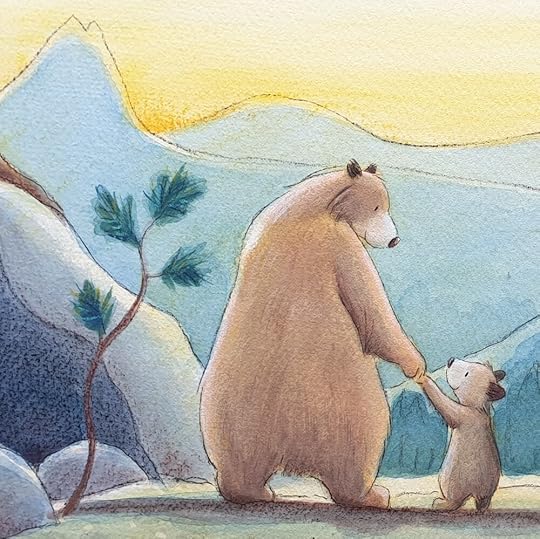
From I Love You as Big as the World by David Van Buren, ill. by Tim Warnes (Little Tiger Press 2008) | Illustration © 2008 by Tim Warnes
Mum and baby.
Dad and baby.
Grandma, Grandad, Uncle …
(And yes, our Heavenly Father.)
You get the idea.
This interchangeability is an integral part of these books’ strength and widespread appeal. From a publishing perspective, it’s also makes good business sense. (Why limit your market, when you can open it right out and achieve more significant sales?)
From an illustrator’s perspective, I’d say: People are hard!
It’s way easier (for me, at least) to draw a family of bears than people.
(Having said that, when it came to illustrating I’m Going to Give You a Bear Hug! and Only you Can Be You! I was given the option of people or animals. I chose people. Yes - it made my job harder. Yes - I was way out of my comfort zone. But I felt the stories deserved the best interpretation, and that meant illustrating people.)
Which leads me to the point I want to discuss.
When illustrating people, how should I make them look? Who should I represent?

From Only You Can Be You! by Nathan and Sally Clarkson, ill. by Tim Warnes (Tommy Nelson) | © Tim Warnes 2019
Representation matters!
That’s why the loss of black actor Chadwick Boseman, who brought to life the superhero, Black Panther, is so impactful. In him, black kids finally got to see someone with the same skin colour play the role of a superhero.
For precisely the same reason, picture books must represent not only White but Black, Asian and all ethnic minorities. There should be book that promote the Black Lives Matter movement; we must learn about slavery, and celebrate influential civil rights activists, like Gandhi or Rosa Parks. But perhaps as valuable are picture books which portray the ‘normal’, everyday lives, of black and ethnic families doing ‘normal’, everyday things.
(Why? Because studies reveal that in their first few years, even babies pick up a lot of social information. Meaning exposure to diversity during the early years is vital if we want to see a change in society - and picture books play a part in this.)
Experts emphasise: it’s never too early to start openly talking about race with your children.
- These Books Can Help You Explain Racism and Protest to Your Kids, The New York Times
There has been a definite increase in such picture books, as the industry (including picture book creators) begins to reassess its roles and responsibilities. To be honest about our failings and shortcomings. And to find a positive (and more inclusive) way forward.
Sadly, in the past, the industry has used the argument that not enough people would buy a book about a brown/black family. I have heard that myself, straight from the mouth of a publisher (although admittedly, that was many years ago). Whether that’s true or not, it’s really tragic - and leads to non-white families not being honoured and served.
So what is being done to address the imbalance?
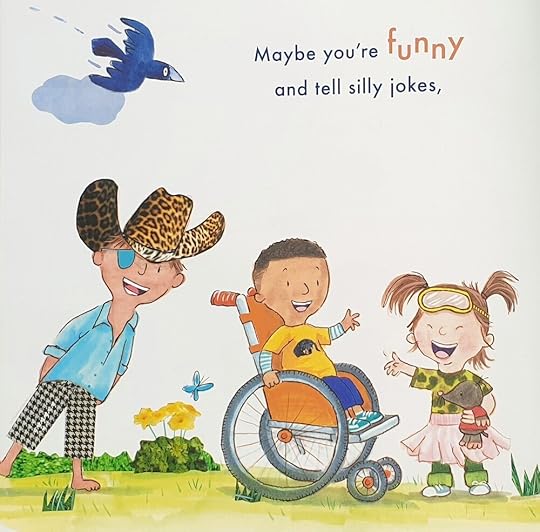
From Only You Can Be You! by Nathan and Sally Clarkson, ill. by Tim Warnes (Tommy Nelson) | Text © 2019 by Nathan and Sally Clarkson |Illustration © Tim Warnes 2019
Aside from publishers beginning to accept responsibility, non-profit organisations such as We Need Diverse Books are proclaiming their message loud and clear: children’s books should reflect and honour the lives of all young people. On a practical level, WNDB are creating opportunities for people from minority backgrounds to enter into the children’s publishing industry by working with publishers to create internships. They are developing mentorships, and amplifying the voices of black creators.
In previous articles, I have described my own personal journey, reflecting on my illustration work and the choices I made. The main reason I took on Only You Can Be You! was that it celebrated diversity and the individual - allowing me to illustrate a diverse cast with a multitude of skin tones.
Likewise, two recent projects from 2019 that have yet to be published will add to the growing list of picture book titles that reflect ethnic minority groups:
It’s Bedtime, Charlie! (DMind & the Prince) and I’m Going to Give You a Polar Bear Hug! (Zonderkidz). Both are scheduled for publication later this year.
My mandate for my business is to connect adults with kids through stories worth sharing.
My primary role is a storyteller/picture book creator.
Within that, I would like to explore how I can help promote the diversity cause and contribute to the change in society that so many are desperate to see. Articles like this seem a good place to start.
Back to the bears on my desk.I’m excited! I Love You Night and Day will deliver a hefty dose of love and tenderness and sit comfortably with the other two titles. In other words, it is sure to gain fans and win the hearts of families all over the place.
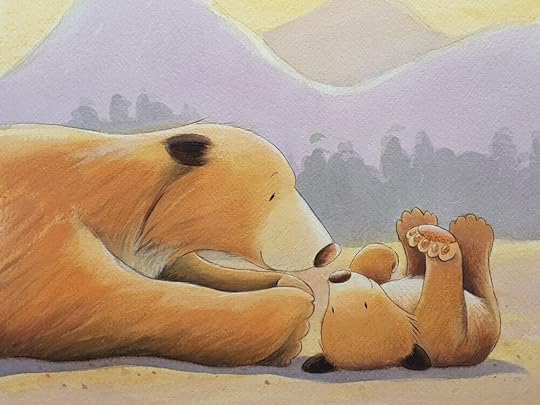
Unused art from I Love You as Big as the World by David Van Buren, ill. by Tim Warnes (Little Tiger Press 2008) | Illustration © 2008 by Tim Warnes
Next week I will be highlighting a new picture book: The Suitcase by Chris Naylor-Ballesteros.
Good to ReadAt a time when over 65 million people are forcibly displaced around the world, this beautifully illustrated and wise, gentle tale of tolerance and kindness for fellow humans resonates deeply. I hope all parents share The Suitcase with their children.
- Khaled Hosseini, author of The Kite Runner
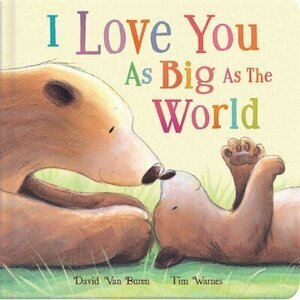
Buy UK
Buy US
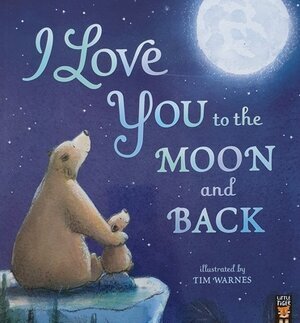
Buy UK
Buy US
SourcesONLY YOU CAN BE YOU - WHAT MAKES YOU DIFFERENT MAKES YOU GREAT! BY NATHAN AND SALLY CLARKSON, ILL. BY TIM WARNES (TOMMY NELSON 2019)I Love You as Big As the World BY DAVID VAN BUREN, ILL. BY TIM WARNES (LITTLE TIGER PRESS 2008 Obituary: Representative John Lewis by Barrett Holmes Pitner (18 July, 2020 bbc.com)Holy Bible, New International Version®, NIV® Copyright © 1973, 1978, 1984, 2011 by Biblica, Inc.The New York Times Parenting Newsletter (August 8, 2020)These Books Can Help You Explain Racism and Protest to Your Kids By Jessica Grose (The New York Times June 2, 2020)We Need Diverse Books I’m Going to Give You a Polar Bear Hug! by Caroline B. Cooney, ill. by Tim Warnes (Zonderkidz 2020)I Love You Night and Day by Amelia Hepworth, ill. by Tim Warnes (Little Tiger Press 2021)ONLY YOU CAN BE YOU - WHAT MAKES YOU DIFFERENT MAKES YOU GREAT! BY NATHAN AND SALLY CLARKSON, ILL. BY TIM WARNES (TOMMY NELSON 2019)SILENT NIGHT BY JULIET GROOM, ILL. BY TIM WARNES (LITTLE TIGER PRESS 2010)I LOVE YOU TO THE MOON AND BACK BY AMELIA HEPWORTH (LITTLE TIGER PRESS 2015)
August 28, 2020
Super Isaac: What makes him different makes him great!
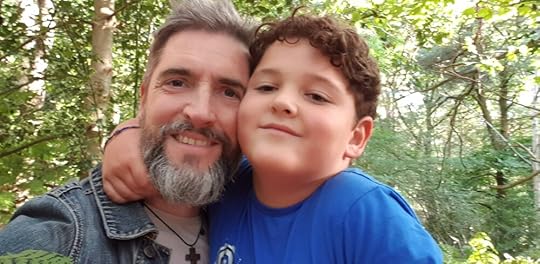
Normal is not something to aspire to, it’s something to get away from.
— Jodie Foster
I have spent the last few weeks with my family, including precious time with my eight-year-old nephew, Super Isaac.
Isaac is forgiving and loving.
Cheeky and funny.
Affectionate and expressive, I have written about Isaac before on this blog.
He has a beautiful imagination and talks about 'his world' - Happy World, whose inhabitants are anthropomorphic animals. (It's a bit like Richard Scarry's Busy Town. In his world, Isaac imagines he's a border collie who drives a big, racing-green van!)
Somewhere in his head, Isaac also has a calendar. It totally blows my mind: if you tell him your birthday (for example,12th February), he will be able to tell you which day of the week it falls on.
In any year.
(I'm telling you - when he's older, he'll never have to pay for his drinks!)
Being with Isaac got me thinking about one of the more recent books I've illustrated: Only You Can Be You - What Makes You Different Makes You Great! by Sally and Nathan Clarkson (Tommy Nelson 2019):
The irresistible rhymes paired with Tim Warnes's whimsical illustrations encourage your children with reassurance in their own uniqueness. Whether they are quiet or artistic, funny or boisterous, your children will love this heartwarming read that assures them they're wonderful exactly as they are.
- Publisher’s blurb

From Only You Can Be You! by Nathan and Sally Clarkson, ill. by Tim Warnes (Tommy Nelson) | © Tim Warnes 2019
I didn’t mention (though you may have guessed): Isaac also happens to be autistic.
It would be too easy to view Isaac's autistic traits (for example, occasional stimming and obsessive conversations) as abnormal. Or, to see those differences in a negative light. Instead, the family have embraced them, and we celebrate Isaac for who he is: a totally unique creation! To be honest, he's a breath of fresh air and great company, and I am blessed to have him in my life.
Yep - Super Isaac is one of a kind.

In a world where the message is that you need to look and act like everyone else, Sally Clarkson and her son Nathan … have written another book to help kids (of all ages) realize they are perfect with all their differences and quirks!!
- Good reads
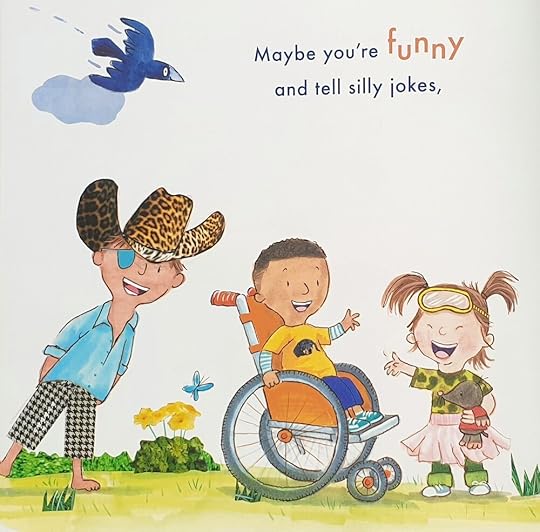
From Only You Can Be You! by Nathan and Sally Clarkson, ill. by Tim Warnes (Tommy Nelson) | Text © 2019 by Nathan and Sally Clarkson |Illustration © Tim Warnes 2019
There are times when we all feel like the odd-one-out. Some are constantly reminded that they are different.
I never felt like I really fitted in when I was a kid.
Quiet and creative.
Sensitive.
Anything vaguely sporty bored me stupid, so that ruled out any football connection with the boys. Instead, like a young Gerald Durrell, my passions lay with birds and nature. (Plus drawing, reading and writing, of course!)
Insecure in my own identity, I hid those interests as best I could. (I have learned to embrace the bird nerd in me: so you'll find a vast array of birds in these illustrations. I even snuck a birdwatcher in there, in honour of my younger self.)
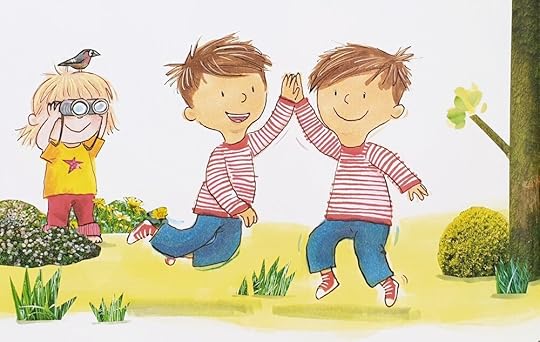
From Only You Can Be You! by Nathan and Sally Clarkson, ill. by Tim Warnes (Tommy Nelson) | © Tim Warnes 2019
Maybe you know a kid who feels like they don't fit in - or that feels misunderstood? In which case I would recommend you share Only You Can be You!
The book has been really well received - with a consistent five-star customer rating on Amazon (and a solid 4.5 on GoodReads) - partly because it sends a reassuring message to neurodiverse kids (like Super Isaac) and those on the spectrum:
Everyone's different, and that's okay!
But don't be fooled into thinking its value is reserved only for kids who fit into that bracket. (What is 'normal' anyway?) The book's core message extends well beyond one group of individuals.
It embraces racially diverse characters (something the public have been crying out for).
It celebrates the fact that, whatever you look like, however you behave - we are all unique creations. A message that, as one reviewer wrote, 'is so needed in this divided world.'
On Good Reads, another wrote, 'This book is sure to lay a good foundation, the kind that we want our lives and kids' lives to be built upon.'
Everyone's different, and that's okay.
The Maker of everything made us that way.
Finally, here’s author Nathan Clarkson explaining what motivated him to create the book:
This book was written to my younger self. This book was written to the kid who doesn't fit in. This book was written to the kid who feels like they're always too much. This book was written to the out-of-the-box kids to help them know from a young age, the uniqueness God has created you and others with is GOOD!
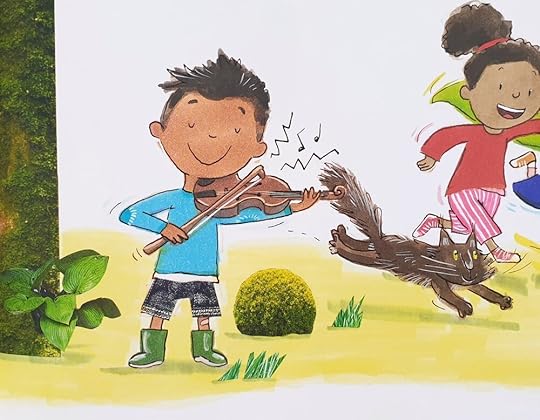
From Only You Can Be You! by Nathan and Sally Clarkson, ill. by Tim Warnes (Tommy Nelson) | © Tim Warnes 2019
GOOD TO READ
Other picture books that celebrate the individual
So Much by Trish Cooke, ill. by Helen Oxenbury (Walker Books 1994)
Tad by Benji Davies (HarperCollins 2019)
Julian is a Mermaid by Jessica Love (Candlewick Press 2018)
Lavender by Posy Simmonds (Red Fox 2003)
Naked Mole Rat Gets Dressed by Mo Willems (Hyperion, 2009)
Available in hardback and board book versions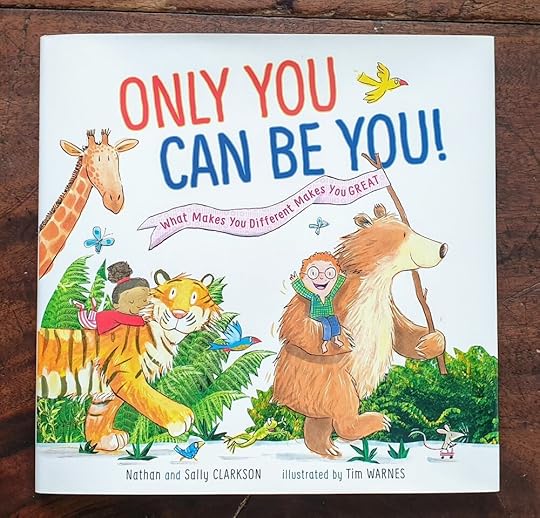
Only You Can Be You! by Nathan and Sally Clarkson, ill. by Tim Warnes (Tommy Nelson) | © Tim Warnes 2019
AMAZON REVIEW S:
‘Colorfully and creatively illustrated’
‘As the mom of three two of which are special needs makes me love this message even more.’
‘be inspired by the diversity of children and animals throughout the book’
‘The message … is so needed in this divided world.’
Buy US
Buy UK
Sources Being unique quotes (elevate.com)ONLY YOU CAN BE YOU - WHAT MAKES YOU DIFFERENT MAKES YOU GREAT! BY NATHAN AND SALLY CLARKSON, ILL. BY TIM WARNES (TOMMY NELSON 2019)NATHAN CLARKSON ON INSTAGRAM
August 14, 2020
Should you feel guilty for loving 'The Cat in the Hat'? (Revisited)

© 1957 by Dr Seuss
Having only a first-grade mind, I can recommend [The Cat in the Hat] as irresistible.
— Los Angeles Times review, 1957
I initially posed this question in March 2019.
A heck of a lot has happened in the world since then, and discussions surrounding race and bigotry have become even more high profile. So I thought maybe it would be a good time to revisit my original article and ask once more: Should you feel guilty for loving The Cat in the Hat?
The Cat in the Hat is the ninth best-selling children’s book of all time! I often perform it when I visit schools. It is unashamedly joyful, with drama, suspense and a natural cadence. Put simply, it is (as the Cat himself would say), “lots of good fun that is funny.”
Perhaps a more pertinent question would be: Is The Cat in the Hat racist? There’s plenty of evidence to suggest that Dr Seuss spoke and behaved in ways that we would consider racist today. During World War II (before adopting the pen name ‘Dr Seuss’), Theodor Seuss Geisel worked as a political cartoonist.
Many of these [political] drawings featured racist portrayals of Japanese citizens and Japanese Americans. The cartoons ranged from stereotypical caricatures to fear-inducing propaganda that vilified people of Japanese descent and justified their internment.
- Kids Use 'Dr. Seuss Week' To Teach Classmates About His Racist Cartoons By Caroline Bologna (HuffPost, June 3 2017)
Seuss’ cartoons undeniably fueled racist attitudes, and helped gain public support for the incarceration of Japanese Americans in U.S. concentration camps. They are racist propaganda created in the context of a World War - and they are uncomfortable to look at.
They are also in the tradition of satirical, political cartoons. Does that excuse them, or make them OK?
No.
But do they make the iconic Cat in the Hat racist propaganda, too? Again, I would argue no.
Let me explain why.
To me, he’s simply a goofy-looking creature that (very loosely) resembles a cat (in a hat). The way he spins his umbrella, he reminds me of another clown, Charlie Chaplin. And Gene Kelly, as he sings in the rain. So personally, I’m cool with the Cat.
But critics of Seuss find the book problematic. They support Professor Philip Nel’s allegation in his book, Was the Cat in the Hat Black?, that the Cat’s appearance was ‘inspired by blackface performance, racist images in popular culture, and actual African Americans.’ Nel’s work sparked further study, leading scholars to conclude that Seuss’s Cat transmits ‘anti-Black, and White supremacist messaging through allegories and symbolism.’ (St. Catherine University’s Research on Diversity in Youth Literature.)
However, a recent (and highly praised) biography of Dr Seuss reveals that his beloved creation was inspired by two culturally significant feline characters:
The syndicated Krazy Kat (‘all the way down to a red bow tie’)
And Felix the Cat (‘Geisel’s cat would walk and act with a similar swagger and confidence’).
These characters are, as with many cultural markers from the time, not without their own controversies.
But their influence is undeniable. (Blackface performers, less so.)

Krazy Kat by George Herriman (Public Domain) | Source: openculture.com

Felix the Cat by Pat Sullivan | Source: icollector.com
‘Claims that the Cat’s physical attributes mirror blackface performers seems a bit tenuous to me,’ I wrote in my original article. Maybe Seuss was inspired by those acts. (He is known to have written and performed in minstrel shows himself.) Perhaps (as is claimed) the elevator operator at HarperCollins was the source for the Cat’s ‘white gloves... sly smile, and... color’. But does that make the Cat - as a character - offensive?
Personally, I think saying that the Cat in the Hat reinforces/perpetuates racist stereotypes is far fetched - and claiming so is forcing an agenda. Ironically, that only serves to dilute the real issue. Yes, there is a problem: Society is racially biased to favour White people, resulting in a dire lack of diversity. Sadly, the publishing industry (including the world of children’s books) is not exempt. Which is why there is a clarion call - not only to diversify the characters that feature in picture books - but also to create opportunities so that the workforce is more diverse - from the top down.

© 1957 by Dr Seuss
SO SHOULD YOU FEEL GUILTY FOR LOVING THE CAT IN THE HAT?
I don’t think so. The reason it’s so popular and enduring is simple. It’s a great story that warrants more than one reading.
Professor Philip Nel, of Kansas State University, would disagree: ‘“I don’t think nostalgia is a defense. Affection is not a defense,” he told Education Week. However, I do agree with Nel when he says, “What you have to do is take a deep breath, step back, and realize that the culture in which these books live and in which these books were written is a racist culture and a sexist culture.”
The culture the professor refers to (late 1950s America) is sixty years in our past. If we want things to change (and let’s face it, there are some ugly similarities) we must have these discussions. And sometimes they are uncomfortable.
But we must be brave.
Then we must allow the lessons learned to inform and guide our decisions.
Picture books are powerful tools. Why? Because they help shape the minds of the future. So if we want the future to be inclusive and diverse, then picture books are a good place to start implementing the change.
The Cat in the Hat continues to be successful because it is Good to Read.
I’m not simply being nostalgic. I’m appealing to common sense.
So please - let’s not throw out the cat and the cup and the milk and the cake with the bathwater.
Because I, for one, would miss him.
read my original article: Should you feel guilty for loving The Cat in the Hat ?SOURCESTHE CAT IN THE HAT 40TH ANNIVERSARY EDITION BY DR. SEUSS (HARPERCOLLINS 1997) Should you feel guilty for loving the Cat in the Hat? by Tim Warnes (My Life in Books, March 15, 2019)Becoming Dr Seuss: Theodor Geisel and the Making of an American Imagination by Brian Jay Jones (Dutton, 2019) Kids Use 'Dr. Seuss Week' To Teach Classmates About His Racist Cartoons By Caroline Bologna (HuffPost, June 03, 2017) THE CAT IS OUT OF THE BAG: ORIENTALISM, ANTI- BLACKNESS, AND WHITE SUPREMACY IN DR. SEUSS’S CHILDREN’S BOOKS - by KATIE ISHIZUKA AND RAMON STEPHENS (Research on Diversity in Youth Literature: Vol.1, Issue 2, Article 4, Feb 2019)The fascinating story of how Theodor Geisel, a.k.a. Dr. Seuss, created The Cat in the Hat By David Canfield (entertainment Weekly, May 02, 2019)Was the Cat in the Hat Black?: Exploring Dr. Seuss’s Racial Imagination, by Philip Nel (John Hopkins University Press, 2014)Dr Seuss Books Like Horton Hears a Who! Branded Racist and Problematic in New Study By Sam Gillette (People.com, February 28, 2019)WIKIPEDIAShould you feel guilty for loving </em#x3E;? (Revisited)

© 1957 by Dr Seuss
Having only a first-grade mind, I can recommend [The Cat in the Hat] as irresistible.
— Los Angeles Times review, 1957
I initially posed this question in March 2019.
A heck of a lot has happened in the world since then, and discussions surrounding race and bigotry have become even more high profile. So I thought maybe it would be a good time to revisit my original article and ask once more: Should you feel guilty for loving The Cat in the Hat?
The Cat in the Hat is the ninth best-selling children’s book of all time! I often perform it when I visit schools. It is unashamedly joyful, with drama, suspense and a natural cadence. Put simply, it is (as the Cat himself would say), “lots of good fun that is funny.”
Perhaps a more pertinent question would be: Is The Cat in the Hat racist? There’s plenty of evidence to suggest that Dr Seuss spoke and behaved in ways that we would consider racist today. During World War II (before adopting the pen name ‘Dr Seuss’), Theodor Seuss Geisel worked as a political cartoonist.
Many of these [political] drawings featured racist portrayals of Japanese citizens and Japanese Americans. The cartoons ranged from stereotypical caricatures to fear-inducing propaganda that vilified people of Japanese descent and justified their internment.
- Kids Use 'Dr. Seuss Week' To Teach Classmates About His Racist Cartoons By Caroline Bologna (HuffPost, June 3 2017)
Seuss’ cartoons undeniably fueled racist attitudes, and helped gain public support for the incarceration of Japanese Americans in U.S. concentration camps. They are racist propaganda created in the context of a World War - and they are uncomfortable to look at.
They are also in the tradition of satirical, political cartoons. Does that excuse them, or make them OK?
No.
But do they make the iconic Cat in the Hat racist propaganda, too? Again, I would argue no.
Let me explain why.
To me, he’s simply a goofy-looking creature that (very loosely) resembles a cat (in a hat). The way he spins his umbrella, he reminds me of another clown, Charlie Chaplin. And Gene Kelly, as he sings in the rain. So personally, I’m cool with the Cat.
But critics of Seuss find the book problematic. They support Professor Philip Nel’s allegation in his book, Was the Cat in the Hat Black?, that the Cat’s appearance was ‘inspired by blackface performance, racist images in popular culture, and actual African Americans.’ Nel’s work sparked further study, leading scholars to conclude that Seuss’s Cat transmits ‘anti-Black, and White supremacist messaging through allegories and symbolism.’ (St. Catherine University’s Research on Diversity in Youth Literature.)
However, a recent (and highly praised) biography of Dr Seuss reveals that his beloved creation was inspired by two culturally significant feline characters:
The syndicated Krazy Kat (‘all the way down to a red bow tie’)
And Felix the Cat (‘Geisel’s cat would walk and act with a similar swagger and confidence’).
These characters are, as with many cultural markers from the time, not without their own controversies.
But their influence is undeniable. (Blackface performers, less so.)

Krazy Kat by George Herriman (Public Domain) | Source: openculture.com

Felix the Cat by Pat Sullivan | Source: icollector.com
‘Claims that the Cat’s physical attributes mirror blackface performers seems a bit tenuous to me,’ I wrote in my original article. Maybe Seuss was inspired by those acts. (He is known to have written and performed in minstrel shows himself.) Perhaps (as is claimed) the elevator operator at HarperCollins was the source for the Cat’s ‘white gloves... sly smile, and... color’. But does that make the Cat - as a character - offensive?
Personally, I think saying that the Cat in the Hat reinforces/perpetuates racist stereotypes is far fetched - and claiming so is forcing an agenda. Ironically, that only serves to dilute the real issue. Yes, there is a problem: Society is racially biased to favour White people, resulting in a dire lack of diversity. Sadly, the publishing industry (including the world of children’s books) is not exempt. Which is why there is a clarion call - not only to diversify the characters that feature in picture books - but also to create opportunities so that the workforce is more diverse - from the top down.

© 1957 by Dr Seuss
SO SHOULD YOU FEEL GUILTY FOR LOVING THE CAT IN THE HAT?
I don’t think so. The reason it’s so popular and enduring is simple. It’s a great story that warrants more than one reading.
Professor Philip Nel, of Kansas State University, would disagree: ‘“I don’t think nostalgia is a defense. Affection is not a defense,” he told Education Week. However, I do agree with Nel when he says, “What you have to do is take a deep breath, step back, and realize that the culture in which these books live and in which these books were written is a racist culture and a sexist culture.”
The culture the professor refers to (late 1950s America) is sixty years in our past. If we want things to change (and let’s face it, there are some ugly similarities) we must have these discussions. And sometimes they are uncomfortable.
But we must be brave.
Then we must allow the lessons learned to inform and guide our decisions.
Picture books are powerful tools. Why? Because they help shape the minds of the future. So if we want the future to be inclusive and diverse, then picture books are a good place to start implementing the change.
The Cat in the Hat continues to be successful because it is Good to Read.
I’m not simply being nostalgic. I’m appealing to common sense.
So please - let’s not throw out the cat and the cup and the milk and the cake with the bathwater.
Because I, for one, would miss him.
read my original article: Should you feel guilty for loving The Cat in the Hat ?SOURCESTHE CAT IN THE HAT 40TH ANNIVERSARY EDITION BY DR. SEUSS (HARPERCOLLINS 1997) Should you feel guilty for loving the Cat in the Hat? by Tim Warnes (My Life in Books, March 15, 2019)Becoming Dr Seuss: Theodor Geisel and the Making of an American Imagination by Brian Jay Jones (Dutton, 2019) Kids Use 'Dr. Seuss Week' To Teach Classmates About His Racist Cartoons By Caroline Bologna (HuffPost, June 03, 2017) THE CAT IS OUT OF THE BAG: ORIENTALISM, ANTI- BLACKNESS, AND WHITE SUPREMACY IN DR. SEUSS’S CHILDREN’S BOOKS - by KATIE ISHIZUKA AND RAMON STEPHENS (Research on Diversity in Youth Literature: Vol.1, Issue 2, Article 4, Feb 2019)The fascinating story of how Theodor Geisel, a.k.a. Dr. Seuss, created The Cat in the Hat By David Canfield (entertainment Weekly, May 02, 2019)Was the Cat in the Hat Black?: Exploring Dr. Seuss’s Racial Imagination, by Philip Nel (John Hopkins University Press, 2014)Dr Seuss Books Like Horton Hears a Who! Branded Racist and Problematic in New Study By Sam Gillette (People.com, February 28, 2019)WIKIPEDIAAugust 7, 2020
Counting cockatoos with Quentin Blake

From Cockatoos by Quentin Blake (Jonathan Cape 1992) | © 1992 by Quentin Blake
Things are not always as they seem; the first appearance deceives many.
— Phaedrus
Whenever I go to a zoo, I always make sure I visit the tropical house.
The very best act as giant aviaries, with free-flying tropical birds, squeaking and squawking, sneaking about in the lush undergrowth. And I always think to myself: This would make a fantastic studio!

Sketchbook: Tropical house, Chester Zoo | © 2017 by Tim Warnes
My Good to Read recommendation this week features just such a glorious aviary-come-glasshouse - complete with an assortment of rather cheeky parrots! It’s the wonderful Cockatoos (Jonathan Cape 1992), by the inaugral Children’s Laureate, Sir Quentin Blake.
Quentin Blake had long wanted to create a story, featuring a man and his troupe of cockatoos. Blake finally found inspiration while house hunting in France, where he came across an old, rambling, run-down Gite. ‘There was a conservatory, the traditional cellar, an ancient stove with its long metal chimney,’ he recalls in Words and Pictures.
Enter Professor Dupont. Elderly, prim and proper (not unlike a slim Poirot). The professor has his daily routine: get washed and dressed (in a three-piece suit and tie), descend the staircase and greet the cockatoos living in his conservatory.
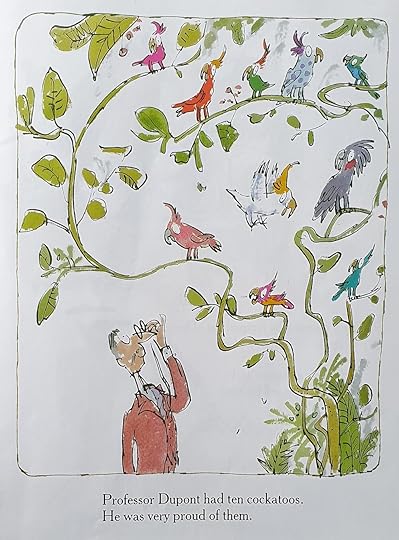
From Cockatoos by Quentin Blake (Jonathan Cape 1992) | © 1992 by Quentin Blake
Professor Dupont threw wide his arms.
… “Good morning, my fine feathered friends!”
Every morning he said the same thing.
The day came when the cockatoos thought they would go mad if they had to listen to the same words once again.
So the weary cockatoos - all ten of them - fly the coop (or rather, escape ‘through a broken pane of glass they had discovered in a corner of the conservatory’). And this is where the fun begins!
Where could all the cockatoos have got to?

From Cockatoos by Quentin Blake (Jonathan Cape 1992) | © 1992 by Quentin Blake
Blake’s simple tale suddenly morphs into a counting book - as well as a game of hide-and-seek! Professor Dupont searches every room of his elaborate, old house without spotting them—but readers will, for they’re all there, slightly concealed.
- Kirkus reviews
‘I normally leave out backgrounds if I don’t need them,’ explains Blake, ‘but in [Cockatoos] each spread is set in a different room of the house. I enjoyed drawing in all the French detail.’

From Cockatoos by Quentin Blake (Jonathan Cape 1992) | © 1992 by Quentin Blake
Blake’s illustrations are unmistakable (often copied but never matched). Joyfully drawn with apparent abandon, Blake himself has described them as “deceptively slapdash”. Deceptively is the keyword here, as anyone who has tried to handle watercolour and a dip pen will testify.
On visiting Blake’s studio, one journalist, observing Blake’s neatly arranged desk, notes that ‘there’s still an air of chaos hovering over his drawing board. A sense of exuberance waiting to be unleashed.’
That sense of exuberance is apparent in all Blake’s work - and Cockatoos is no exception.
Aside from the art, Cockatoos is a joy to read aloud! I like to give the professor a vaguely French-sounding accent, and relish the satisfying way in which his name - Professor Dupont - rolls off the tongue.

From Cockatoos by Quentin Blake (Jonathan Cape 1992) | © 1992 by Quentin Blake
Remember that old, French house which first inspired Blake?
“… [A]s I climbed the steep stairs to the grenier,” he explains in Words and Pictures, “there in front of me was a row of suitcases arranged, just as you see them in Cockatoos. All that was lacking was a cockatoo behind each.”
It’s one of my favourite spreads from the book, and I often talk about it when I visit schools.
Blake’s illustration both complements and contrasts with the text - and this is the book’s hidden superpower!
Let me explain.
Learning to read is hard for many, many children. They spend their early years being told what they can and can’t do, and must fit in with an adult’s timeframe.
So any opportunity for them to feel independent, smart, and in control is a healthy thing. Cockatoos does precisely that. Because it empowers children, giving them the satisfaction of reading a story for themselves, long before they can even recognise words.
‘The text is entirely from poor baffled Professor Dupont’s point of view,’ explains Blake. ‘[T]he written story hasn’t the first idea about the naughtiness that is going on in the pictures.’
[Professor Dupont] climbed a ladder and flashed his torch around the attic. They weren’t there.
But when you look closely - there are the escapees, hiding behind the cases! As the story progresses, each subsequent page turn reveals an additional cockatoo. Until finally, Professor Dupont is reunited with all ten of his feathered friends, who return the following day of their own free will. (Giving Blake the opportunity for one last little twist right at the very end...)

From Cockatoos by Quentin Blake (Jonathan Cape 1992) | © 1992 by Quentin Blake
This juxtaposition of two realities is absolutely critical to the story because it reveals something to the reader that they do not find in the text. ‘It is an old and useful tool in the picture book maker’s kit,’ says Blake, ‘and Cockatoos could not exist without it.’
Cockatoos is Good to Read because:‘As one friend put it to me: “When I read it to my son I am reading one story in the words and he is reading another story in the pictures.”’
- Words and Pictures by Quentin Blake
It’s funny!
No matter how many times you read it, there is always one cockatoo that is tricky to find…
You can have fun giving Professor Dupont a vaguely French-sounding accent!
It develops kids’ visual literacy skills.
It empowers young children - allowing them to experience the pleasure of reading a story for themselves.
It gives kids the satisfaction of getting one up on the adult, and contradicting their version of events!
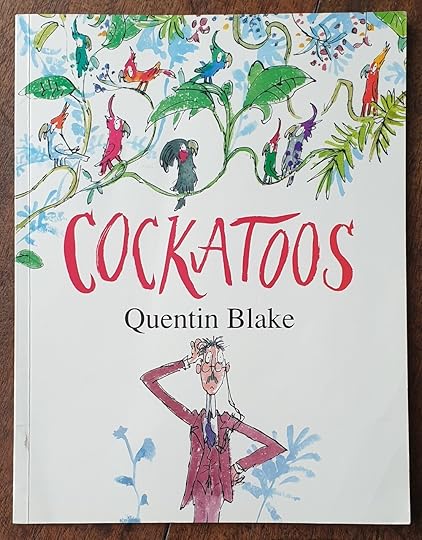
‘There has never been, and probably never will be, a counting book as funny and
delightful as this’
- Books For Young ChildrenBuy UK
SourcesCockatoos by Quentin Blake (Jonathan Cape 1992) ‘Things are not always as they seem; the first appearance deceives many ’ by Phaedrus (brainyquote.com)Sketchbook by Tim Warnes (2017)Words and Pictures by Quentin Blake (Jonathan Cape 2000) Cockatoos by Quentin Blake (Kirkus.com, 1 Sept 1992) Interview with Quentin Blake (bl.uk, 21 Feb 2020)I never wanted children. But I do invent them: Interview with Quentin Blake by John Preston (The Telegraph Magazine, 04 Nov 2012) © 2020 BY TIM WARNES (UNLESS OTHERWISE ATTRIBUTED)****USE OF THIRD PARTY COPYRIGHTED MATERIAL FALLS UNDER FAIR USE/FAIR DEALING PRACTICE.
July 31, 2020
Exploring emotions with Penguin

Penguin by Polly Dunbar (Walker Books 2007) | © 2007 by Polly Dunbar
Children use books to discover the rules by which the world works, then delight in finding stories that subvert those same rules.
— Wild Things!
My Good to Read recommendation this week is an old family favourite: the delightful Penguin by Polly Dunbar (Walker Books 2007).
You could pigeon hole this best-selling award winner as a subversive morality tale, in the tradition of Hilaire Belloc’s cautionary tales (or Hoffman’s dark Struwwelpeter). But Dunbar dispenses with fear, horror and gore in favour of colour, warmth and humour.
Out of all her books, Dunbar says, “Penguin is my absolute favourite to read out loud.” It begins with a present for Ben, who is clearly delighted to open it and find a penguin inside! But when Ben tries to engage the penguin, it does not answer. It is silent and static.

Penguin by Polly Dunbar (Walker Books 2007) | © 2007 by Polly Dunbar
“Can’t you talk?” said Ben.
Penguin said nothing.
Nothing Ben tries will provoke a reaction. Not tickling, or funny faces, or the singing of silly songs in a happy hat.
Penguin just won’t speak.
Ben’s delight in his new friend begins to sour.
‘So Ben prodded Penguin and blew a raspberry at Penguin.’ Still ‘Penguin said nothing.’

Penguin by Polly Dunbar (Walker Books 2007) | © 2007 by Polly Dunbar
Ben ramps things up - he makes fun of the penguin and imitates/mocks him.
Finally, Ben turns his back and ignores Penguin.
The text may be sparse, but Dunbar’s illustrations speak volumes. And this is one of the joys of the book. It’s handy for a quick, ‘just one more story’ before lights out. But it can also be read at length, taking time to discuss the characters’ feelings (in particular, Ben) by interpreting their body language, expertly shown by Dunbar’s drawings.
Feeling sad and rejected, Ben tries to feed Penguin to a passing lion.

Penguin by Polly Dunbar (Walker Books 2007) | © 2007 by Polly Dunbar
Dunbar’s big lion is friendly and blue. He is, unquestionably, an imaginary creature - and he does not want to eat Penguin.
‘This makes Ben shout,’ writes one child reviewer. ‘But then the lion eats Ben because he is being too noisy.’
For a child, subversive books are delightful, precisely because they break the rules and no one stops them.
- Wild Things!
No one stops them?
What about the mysterious, silent Penguin?
Penguin bit Lion very hard on the nose.
OW! said Lion.

Penguin by Polly Dunbar (Walker Books 2007) | © 2007 by Polly Dunbar
Dunbar shares the inspiration behind the story on her website:
Some time ago my brother Ben gave me an old toy penguin. Ben said to me ‘You have to look after this Penguin, he’s very precious, but watch out he BITES!’ I drew a small sketch of a little boy being bitten on the nose by a Penguin, how absurd, I thought and from there the story grew.’
- Polly Dunbar
The Sunday Times describes Penguin as heart-warming, praising the way Dunbar ‘conjures — by minimal means — imagination, anger, danger and love, while encouraging small children to remember events, read pictures and laugh.’
Unlike Belloc’s Jim (who was swallowed by a lion), Ben is spat out. And not only is he whole and unharmed - he appears to be enjoying himself!
WOW! said Ben.
And Penguin said…
The spread that follows is such a great, unexpected page-turn; described in one review as ‘[q]uite simply the best visual representation of emotion ever!’
Penguin finally speaks up - but the story he tells is recounted pictorially.
Booktrust says,
Polly Dunbar’s illustrations are gorgeous and her palette stylish - from the endearing Ben’s rosy cheeks to the magnificent turquoise lion who eats him up.
- Booktrust

Penguin by Polly Dunbar (Walker Books 2007) | © 2007 by Polly Dunbar
Penguin is Good to Read because it is:
Short enough to hold the attention of impatient littlies
Rich enough to warrant a more extended reading session
Colourful, bright and cheery.
Shows kids the importance of communication
Helps develop empathy and visual literacy.
Introduces children to speech bubbles
Funny!
Good to ReadSome other books for penguin fans
The Emperor’s Egg by Martin Jenkins, ill. by Jane Chapman
Lost and Found by Oliver Jeffers
SourcesWild Things! Acts of Mischief in Children’s Literature by Betsy Bird, Julie Danielson and Peter D. Sieruta (Candlewick Press 2014)Penguin by Polly Dunbar (Walker Books 2008) Penguin - review , by Raindrop (The Guardian, 04 November, 2013) Penguin by Nicolette Jones (The Sunday Times) Penguin by Polly Dunbar (lovereading4kidz.co.uk)Penguin by Polly Dunbar (booktrust.co.uk)
‘This brief, brisk story will hold the attention of impatient children, while its messages about easing standoffs through communication and mutual respect bears repeated reading.’
- Booklist
Buy UK
Buy US
My Life in Books
For lovers of kid lit, this memoir - My Life in Books - is intended to give you the confidence and encouragement to share your own passion; to help you make lasting connections through kids’ books.
Originally posted at www.timwarnes.com ...more
- Tim Warnes's profile
- 30 followers



